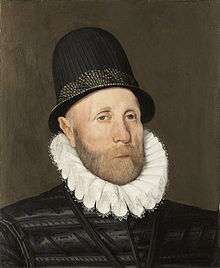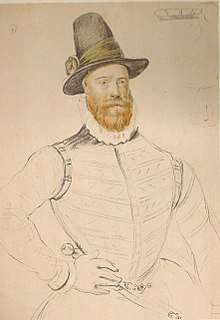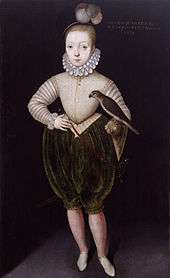Arnold Bronckorst
Arnold Bronckhorst, or Bronckorst or Van Bronckhorst (fl. 1565–1583) was a Dutch painter who was court painter to James VI of Scotland.

Arnold's origins are unknown, and it is unclear if he was a member of the Dutch noble family of Van Bronckhorst.
Goldmining story
According to an account of gold mining in Scotland by Stephen Atkinson written in 1619, Bronckorst was working in London as an associate of the English painter Nicholas Hilliard. With a third painter, Cornelius de Vos, they went to Scotland to invest in gold mining, meeting Regent Morton. According to Atkinson, Hilliard invested in the mine, and Bronckhorst was in Edinburgh negotiating the sale of gold to the mint, unsuccessfully, but he was hired by Morton to paint portraits "great and small" of the young king (later James I of England). The involvement of Hilliard has been doubted by some of his biographers. Cornelius de Vos is recorded as a mineral prospector in Scotland for gold and salt in this period, not a painter.[1] There is a record of a 'French painter' who made a portrait of the King in September 1573, during Morton's regency, for £10.[2] Cornelius de Vos was made to review and lost his contract in 1575, which may reflect Atkinson's description of Bronckhorst negotiating with Regent Morton on behalf of de Vos.[3]
Paintings and records

by Arnold Bronckorst (drawing)
In Scotland, Arnold painted the King, Regent Morton, George Buchanan, and the Earl of Arran.[4] According to the inventories of the Earl of Leicester, the earl had a portrait of the 'young king of Scots' in 1580, which may have been a copy of Arnold's picture.[5] Leicester sent his own portrait to James VI, painted on canvas by Hubbard in 1583.[6]
Arnold was paid £130 Scots for portraits of James VI in April 1580.[7] Sittings for the King's picture by the "Flemish painter", probably Arnold, at Stirling Castle during the difficult political circumstances in 1579 were mentioned in letters sent to George Bowes in England, the brother of the diplomat Robert Bowes, by Archibald Douglas. The portrait, a "portratur", was destined for Robert Bowes to give to Queen Elizabeth. Archibald Douglas supervised the painter and the sittings, and sent the picture to England;[8]
The Flemish painter is in Stirling, in working of the King's portraiture, but expelled forth of the place at the beginnings of thir (these) troubles. I am presently travelling (working) to obtain him license to see the King's presence thrice in the day, till the end of his work; quhilk (which) will be no sooner perfected nor nine days, after the obtaining of this license ...
the king our sovereign's portraiture, according to his proportion in all parts, which has been so long in making, and so difficult in getting, that I have been almost wearied therwith.[9]
A son of George Bowes, also called George, was later sent into Scotland as a mineral prospector at Wanlockhead in 1603 with Sir Bevis Bulmer, which may relate to Stephen Atkinson's gold-mining story.[10] By September 1580, Arnold had completed a half and full length of the king and a portrait of George Buchanan for £64.[11]
After receiving £46 for portraits of James on 6 September 1581, on 19 September 1581 Arnold was appointed to the post of King's Painter, the first such appointment in Scotland. He received a privy seal letter of appointment guaranteeing the payment for life of £100 yearly from the "reddiast of his hienes' casualties and cofferis," meaning the treasurer was to make Arnold's payment a priority.[12] The privy seal letter and account entries describe him as a flemyng. Bronckorst returned to London in 1583 where he disappears from view. He was succeeded as court painter in Scotland by another Flemish artist, Adrian Vanson, who was subsequently appointed King's Painter.[13]
One portrait signed and dated 1578 by Bronckorst survives; the English sitter Oliver St John of Bletso, was the father of a reluctant keeper and juror of Mary Queen of Scots.[14]
Scots portraits
The National Galleries of Scotland hold a number of portraits by Bronckorst:
.jpg) James VI, about 1574
James VI, about 1574.jpg) Regent Arran, print after Arnold Bronckorst, about 1574
Regent Arran, print after Arnold Bronckorst, about 1574.jpg) Regent Morton, about 1580
Regent Morton, about 1580 George Buchanan, about 1581
George Buchanan, about 1581 James VI in 1574, after picture
James VI in 1574, after picture
attributed to Arnold Bronckorst
References
- Stephen Atkinson, The Discoverie and Historie of Gold Mynes in Scotland. 1619 (Bannatyne Club, 1825): Edinburgh Burgh Records 1557–1571 (Edinburgh, 1875), p. 230.
- Accounts Treasurer of Scotland, vol. 12, (Edinburgh, 1970), p. 361.
- HMC Laing Manuscripts, vol. 1 (London, 1914), pp. 25-6.
- MacDonald, Alexander, Archaeologia Scotica, vol. 3 (1831), pp. 312–13.
- Notes & Queries, (1862), p. 225: . Dynfnallt Owen, ed., HMC 58, Manuscripts Marquess of Bath, vol. 5 (London, 1980), p. 203
- G. Dynfnallt Owen, ed., HMC 58, Manuscripts Marquess of Bath, vol. 5 (London, 1980), p. 222: UK National Archives catalogue, Longleat House DU/vol. V, & vol. VI
- Thomson, Duncan, Painting in Scotland, 1570–1650 (Edinburgh, 1975), p. 22.
- Cuthbert Sharp, Memorials of the Rebellion of 1569 (London, 1840), p. 392.
- Tytler, Patrick Fraser (1842). History of Scotland. Vol. 8. Edinburgh: William Tait. p. 418. or Proofs to vol. 4, no. IV; "Letter of intelligence from an anonymous correspondent to Sir George Bowes," undated letter, Spring 1579, (formerly in Bowes manuscripts at Streatlam Castle, Bowes MS vol.6): Duncan Thomson, Painting in Scotland 1570-1650 (Edinburgh, 1975), p. 9.
- Devon, Frederick, ed., Issues of the Exchequer in the Reign of James I (London, 1836), pp. 8–9.
- Thomson, Duncan, Painting in Scotland, 1570–1650 (Edinburgh, 1975), p. 22, citing NRS treasurer's accounts E21/62 fol.19, with voucher E23/5/6: Archaeologia Scotica, vol.3 (1831), p. 313.
- Register of the Privy Seal of Scotland, vol. 8 (Edinburgh, 1982), p. 80 no. 474: Payment in September 1581 for paintings; National Records of Scotland NRS E21/62 f153v and E23/6/17 (voucher), 6 September 1581 for £46 (a portrait costing £30 was sent to the "Princess of Lorraine").
- Register of the Privy Seal of Scotland, vol. 8 (Edinburgh, 1982), p. 396, no. 2287.
- Auerbach, Erna, 'Some Tudor Portraits at the Royal Academy,' in The Burlington Magazine, 99:646 (Jan. 1957), pp. 8–11, 13.
External links

- Biography at the National Galleries of Scotland (accessed 28 September 2007)
- MacDonald, Alexander, 'A Short Notice of Arnold Bronckhorst', in, Proceedings of the Society of Antiquaries of Scotland/Archaeologia Scotica, vol. 3, (1831) pp. 312–313.
- 13 paintings by or after Arnold Bronckorst at the Art UK site
- Arnold Van Bronckhorst
- Arnold Bronckhorst
| Preceded by Pierre Quesnel |
Painter at the Scottish royal court 1580–1583 |
Succeeded by Adrian Vanson |